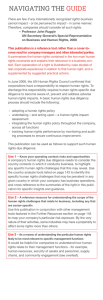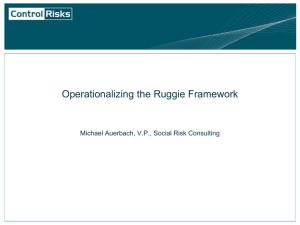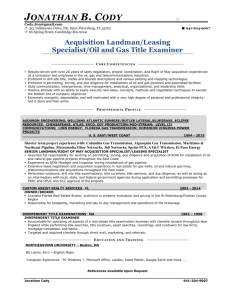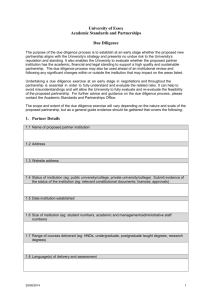Merging the Merger Functions: Due Diligence and Integration Planning Complement Each Other
advertisement
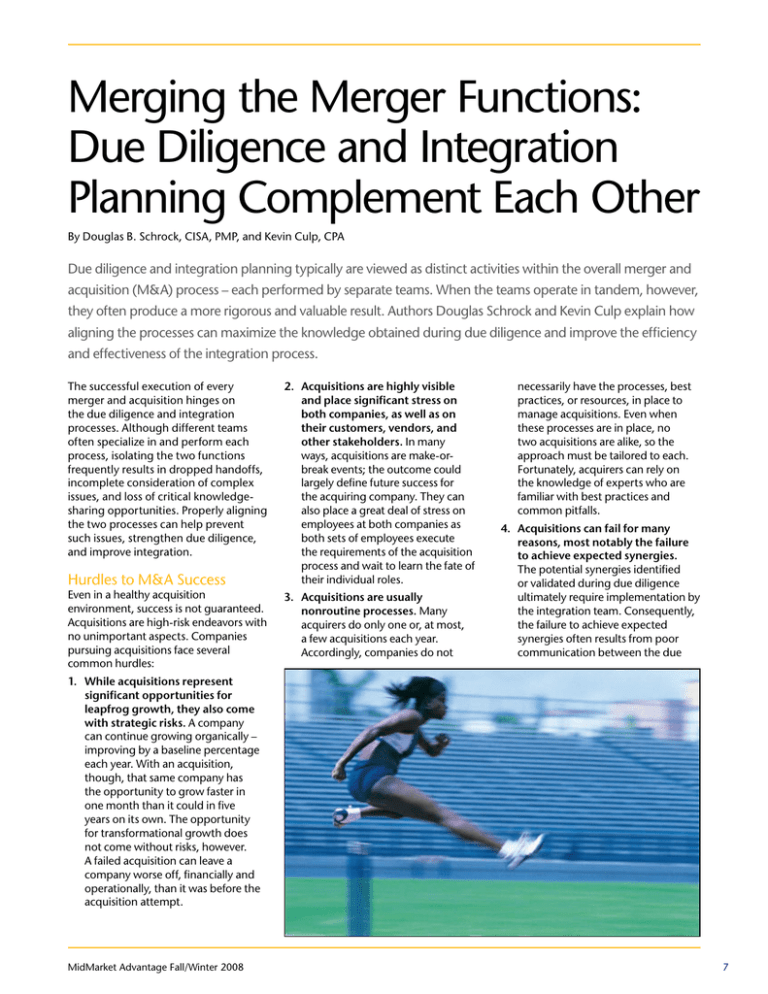
Merging the Merger Functions: Due Diligence and Integration Planning Complement Each Other By Douglas B. Schrock, CISA, PMP, and Kevin Culp, CPA Due diligence and integration planning typically are viewed as distinct activities within the overall merger and acquisition (M&A) process – each performed by separate teams. When the teams operate in tandem, however, they often produce a more rigorous and valuable result. Authors Douglas Schrock and Kevin Culp explain how aligning the processes can maximize the knowledge obtained during due diligence and improve the efficiency and effectiveness of the integration process. The successful execution of every merger and acquisition hinges on the due diligence and integration processes. Although different teams often specialize in and perform each process, isolating the two functions frequently results in dropped handoffs, incomplete consideration of complex issues, and loss of critical knowledgesharing opportunities. Properly aligning the two processes can help prevent such issues, strengthen due diligence, and improve integration. Hurdles to M&A Success Even in a healthy acquisition environment, success is not guaranteed. Acquisitions are high-risk endeavors with no unimportant aspects. Companies pursuing acquisitions face several common hurdles: 2. Acquisitions are highly visible and place significant stress on both companies, as well as on their customers, vendors, and other stakeholders. In many ways, acquisitions are make-orbreak events; the outcome could largely define future success for the acquiring company. They can also place a great deal of stress on employees at both companies as both sets of employees execute the requirements of the acquisition process and wait to learn the fate of their individual roles. 3. Acquisitions are usually nonroutine processes. Many acquirers do only one or, at most, a few acquisitions each year. Accordingly, companies do not necessarily have the processes, best practices, or resources, in place to manage acquisitions. Even when these processes are in place, no two acquisitions are alike, so the approach must be tailored to each. Fortunately, acquirers can rely on the knowledge of experts who are familiar with best practices and common pitfalls. 4. Acquisitions can fail for many reasons, most notably the failure to achieve expected synergies. The potential synergies identified or validated during due diligence ultimately require implementation by the integration team. Consequently, the failure to achieve expected synergies often results from poor communication between the due 1. While acquisitions represent significant opportunities for leapfrog growth, they also come with strategic risks. A company can continue growing organically – improving by a baseline percentage each year. With an acquisition, though, that same company has the opportunity to grow faster in one month than it could in five years on its own. The opportunity for transformational growth does not come without risks, however. A failed acquisition can leave a company worse off, financially and operationally, than it was before the acquisition attempt. MidMarket Advantage Fall/Winter 2008 7 The Acquistion “Doing The Deal” Deal Team “Making The Deal Work” Integration Team “Optimizing the New Company” Performance Team Resource Commitment Waiting Period Origination On-site Due Diligence diligence and integration teams, wherein the integration planning team can make otherwise sound decisions based on inadequate or incomplete decision support information and analysis. Difficulties arise from failing to understand and properly vet the underlying assumptions that provide the basis for the expected synergies. Acquisitions fail when synergy assumptions prove to be unreasonable or unrealistic during integration. The due diligence team, for instance, when valuing the target and evaluating risks, may work from the preliminary assumption that the merged company will increase sales by $20 million. By involving the integration team – which provides realistic input into the critique of how the combined companies would increase sales by $20 million – earlier, the acquirer can effectively engage both integration and due diligence specialists to assess the underlying assumptions driving the expected increase in revenue. Combining their efforts during the preliminary risk assessment and integration planning phase results in an acquisition approach conducive to identifying realistic assumptions about synergies. Avoiding the Silos Due diligence and integration should not be regarded or conducted as distinct processes that don’t overlap. Opportunities exist between the functions to make both processes 8 Signing Transition Closing First 90 Days more effective and efficient. It is, of course, vitally important to maintain the integrity of both due diligence and integration, but proper coordination produces smarter decisions, faster integrations, reduced risk, and a greater likelihood of realizing synergies. The due diligence team should use input from preliminary integration planning to address assumptions related to value drivers, risks, and synergies in designing and executing the due diligence plan. The preferable overlap of the due diligence and integration teams is depicted in the exhibit shown above. Note that the due diligence team (purple line) and the integration team (red line) overlap in the time period before closing. Concurrent work is critical to a smooth handoff and effectively completed acquisition. Following integration work, a subsequent handoff will be made to various optimization teams, which will implement process and technology improvements in the newly merged organization. Investments are required in both due diligence and integration throughout the acquisition process prior to close. These investments are a necessary cost of high-risk acquisitive growth, and coordinating the processes will generate a return on the investments. Exercising discipline is important for an acquirer. While integration planning should not be delayed too long, the acquirer should not jump too deeply or too early, either. Before an acquirer makes substantial integration Normal Operations investments, sufficient due diligence should be completed to allow an accurate assessment of the risks and to identify any deal-breaking issues. Proper timing of integration planning helps an acquirer retain the flexibility to renegotiate transaction terms or even walk away from a deal because of what is uncovered during due diligence. An acquirer should not be overly cautious in deciding when to launch integration planning, however. By the time an acquirer is fairly certain the deal will go through, planning should have already commenced. By involving the integration planning team at the commencement of the due diligence and risk assessment process, coordinated identification of potential risks, value drivers, and synergy assumptions can be achieved and, accordingly, vetted during the due diligence process. Aligning the risk assessment process and focusing the due diligence efforts provides relevant and timely decision support information and analyses to aid more detailed, robust, and meaningful integration planning efforts. The Benefits of Overlapping the Processes An acquirer that begins integration planning early enough to affect due diligence enjoys multiple benefits. The overall acquisition process moves much quicker, for example. The integration planning is expedited because the team can take advantage of information gathered during due diligence. The www.crowehorwath.com integration team need only alert the due diligence team as to specific integration-related information to seek, such as information about human resources, technology, and any potential nonfinancial deal breakers. An acquirer should tackle the preliminary integration planning, risk assessment, and major assumptions at the very beginning of the acquisition process. More detailed integration planning commences when: Parties involved on both sides of the deal will find the process more efficient and less frustrating. Rather than having the due diligence and integration teams making separate but duplicative information requests of the target company, the relevant information is requested and questions are asked just once. 1. Sufficient (but not complete) due diligence has been performed to vet the critical deal breakers; The overlapping approach can reduce risk, too. An acquirer is more likely to uncover problems that could arise in consummating the acquisition. It also minimizes the odds of key information getting lost in the handoff between the due diligence and integration teams. Overlapping due diligence and integration also increases the likelihood of realizing the desired synergies. The assumptions are more realistic because of the integration team’s involvement in formulating them during due diligence. The integration team also may help identify additional synergies. Finding the Right Balance An acquirer should choreograph the due diligence and integration processes to avoid overinvesting resources before the due diligence process has adequately addressed inherent risks and confirmed the major assumptions underlying the rationale for the transaction. A company does not want to invest so much in a deal that it then must be consummated, regardless of later findings, just to recoup costs. 2. Consummation of the deal is likely; and 3. Sufficient data and information on critical integration assumptions and value drivers have been obtained to render detailed planning effective and relevant. The goal is to maximize an acquirer’s ability to accomplish tasks in the desired time frames and minimize the risk of not transferring useful information from one process to the other. action plan, results, and implications drives discipline in the process, allows easy information sharing among the different acquisition teams, and minimizes redundancy. Formal project management and communication techniques facilitate consistent and effective communication. Merge Ahead Most acquirers, often to their detriment, regard due diligence and integration as separate functions. Taking advantage of the due diligence that must be done for valuation and other purposes to complement the integration planning process is beneficial to all involved. The due diligence and integration teams should be familiar with each other’s goals and procedures and should work together and share knowledge throughout the acquisition. Due Diligence Communication The acquisition process is frequently lengthy and complex, and as a result information is easily compartmentalized along the way. Therefore, documentation and communication, particularly communication of due diligence information, is a priority. Due diligence essentially is a decisionsupport and risk-analysis process. Documentation of the due diligence Doug Schrock is an executive with Crowe Horwath LLP in the Indianapolis office. He can be reached at 317.706.2643 or doug.schrock@crowehorwath.com. Kevin Culp is an executive with Crowe Horwath LLP in the Indianapolis office. He can be reached at 317.208.2587 or kevin.culp@crowehorwath.com. At the same time, however, an acquirer must avoid overemphasizing one process at the expense of the other. Overemphasizing integration too early can prove inefficient when resources are invested in solving how-to problems triggered by a transaction that might not occur. Conversely, underemphasizing integration during the acquisition process may put an acquirer at risk of being unable to efficiently and effectively execute the integration to realize the intended benefits. If delays occur on day one because of inadequate planning, the company risks distraction, uncertainty, and reduced productivity. MidMarket Advantage Fall/Winter 2008 9 About Crowe Crowe Horwath LLP is one of the top 10 public accounting and consulting firms in the United States. Under its core purpose of Building Value with Values,® Crowe assists clients in reaching their goals through audit, tax, risk, and consulting services. Crowe professionals provide public and private company clients with thought leadership in many sectors, including financial and diversified financial services, healthcare, government, private equity-sponsored, inventory-based, retail, not-for-profit, higher education, and food and commodities. With more than 20 offices and more than 2,500 personnel, Crowe is recognized by many organizations as one of the country’s best places to work. Crowe serves clients worldwide as a leading independent member of Horwath International. How to Reach Us Visit us on the Web at www.crowehorwath.com or e-mail Katherine Willhoite at katherine.willhoite@ crowehorwath.com. Under U.S. Treasury rules issued in 2005, we must inform you that any advice in this communication to you was not intended or written to be used, and cannot be used, to avoid any government penalties that may be imposed on a taxpayer. If you would like to start receiving information via e-mail about topics of importance to you, please sign up on our Web site at www.crowehorwath.com/emailsignup. www.crowehorwath.com Crowe Horwath LLP is a member of Horwath International Association, a Swiss association (Horwath). Each member firm of Horwath is a separate and independent legal entity. Crowe Horwath LLP and its affiliates are not responsible or liable for any acts or omissions of Horwath or any other member of Horwath and specifically disclaim any and all responsibility or liability for acts or omissions of Horwath or any other Horwath member. Accountancy services in several states are rendered by Crowe Chizek and Company LLC, which is a member of Horwath. This material is for informational purposes only and should not be construed as financial or legal advice. Please seek guidance specific to your organization from qualified advisers in your jurisdiction. © 2008 Crowe Horwath LLP
